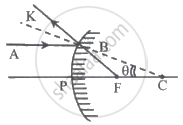Advertisements
Advertisements
Question
Why is oil-immersed objective preferred in a microscope?
Solution
By placing an immersion oil with a refractive index equal to that of the glass slide in the space filled with air, more light is directed through the objective and a clearer image is observed.
APPEARS IN
RELATED QUESTIONS
Answer the following question in detail.
Define and describe the magnifying power of an optical instrument.
Answer the following question in detail.
What is a terrestrial telescope and an astronomical telescope?
Answer the following question in detail.
What is the limitation in increasing the magnifying powers of the astronomical telescope?
What are the advantages and disadvantages of using a reflecting telescope?
What is the remedy of myopia?
What is hypermetropia?
What is presbyopia?
Discuss about simple microscope and obtain the equations for magnification for near point focusing and normal focusing.
Obtain the equation for resolving the power of the microscope.
Mention different parts of the spectrometer.
The near point and the far point for a person are 50 cm and 500 cm, respectively. Calculate the power of the lens the person should wear to read a book held in hand at 25 cm. What maximum distance is clearly visible for the person with this lens on the eye?
There are four convex lenses L1, L2, L3 and L4 of focal length 2, 4, 6 and 8 cm, respectively. Two of these lenses from a telescope of length 10 cm and magnifying power 4. The objective and eye lenses are respectively
The magnifying power of a telescope is nine. When it is adjusted for parallel rays, the distance between the objective and eyepiece is 20 cm. The focal length of objective and eyepiece are respectively.
The magnifying power of a telescope is high if its objective and eyepiece have respectively ______.
The speed of light in media 'A' and 'B' are 2.0 × 1010 cm/s and 1.5 × 1010 cm/s respectively. A ray of light enters from medium B to A at an incident angle 'θ'. If the ray suffers total internal reflection, then ______.
An object viewed from a near point distance of 25 cm, using a microscopic lens with magnification '6', gives an unresolved image. A resolved image is observed at infinite distance with a total magnification double the earlier using an eyepiece along with the given lens and a tube of length 0.6 m, if the focal length of the eyepiece is equal to ______ cm.
The image formed by an objective of a compound microscope is ______.
In the adjoining figure, AB represents the incident ray, and BK is the reflected ray. If angle BCF = θ, then ∠BFP is given by ______.

